Sui erforschen: Der Layer-1 – Bereit für die Massenanwendung
07 November 2024
Sui zeichnet sich dadurch aus, dass es darauf abzielt, die Blockchain so schnell, benutzerfreundlich und erschwinglich wie Plattformen wie Facebook, Twitter und Robinhood zu machen und damit eine Benutzererfahrung zu schaffen, die den meisten Internetnutzern vertraut ist.
Marketing-Anzeige
Das Problem der Benutzerfreundlichkeit bei Kryptowährungen
Kryptowährungen versprechen eine “Be your own bank”-Erfahrung, indem sie es den Menschen ermöglichen, Vermögenswerte ohne Vermittler wie Banken zu versenden und zu speichern. Für viele nicht-technisch versierte Nutzer bleibt die Nutzung von Kryptowährungen jedoch aufgrund der komplexen Schnittstellen und des Risikos des Vermögensverlusts eine Herausforderung. Entwickler sind bei der Entwicklung von Blockchain-Anwendungen mit hohen Kosten und Risiken konfrontiert, da sie über spezielle Fähigkeiten verfügen müssen, um Sicherheit und Effizienz zu gewährleisten.
Die aktuellen Blockchains haben diese Herausforderungen nicht ausreichend berücksichtigt. Um eine Milliarde Nutzer an Bord zu holen, müssen Blockchains billiger, flexibler und vor allem so einfach zu bedienen sein wie ein iPhone. Dies erfordert ein grundlegendes Design, das neben der Skalierbarkeit zur Unterstützung von Milliarden von Transaktionen auch die einfache Anwendung für den Nutzer priorisiert.
Sui zeichnet sich dadurch aus, dass es darauf abzielt, die Blockchain so schnell, benutzerfreundlich und erschwinglich wie Plattformen wie Facebook, Twitter und Robinhood zu machen und damit eine Benutzererfahrung zu schaffen, die den meisten Internetnutzern vertraut ist.
Sui repräsentiert einen enormen Fortschritt auf dem Weg zu diesem ultimativen Wegpunkt dar, da es die folgenden Merkmale aufweist:
- Bemerkenswerte Geschwindigkeit:
- Transaktionen auf Sui werden in weniger als 400 ms verarbeitet
- Hoher Durchsatz:
- Sui hat bewiesen, dass es bis zu 297.000 Transaktionen pro Sekunde verarbeiten kann; die Möglichkeit einer Skalierung auf Millionen von Transaktionen pro Sekunde ist vorhanden.
- Geringe Kosten:
- Transaktionen auf Sui kosten Bruchteile eines Cents
- Logisches, auf Vermögenswerte zentriertes Design:
- Die Architektur von Sui erleichtert es Entwicklern, einfache Benutzererlebnisse zu schaffen
- Engagement für Sicherheit
- Viele Fehler im Anwendungsdesign werden von der Software von Sui zurückgewiesen und sind durch den Anwendungsschutz von Sui ausgeschlossen
- Einfache Entwicklererfahrung
- Die Programmiersprache von Sui, genannt Move, ist so flexibel wie die beliebte Sprache Rust, wurde aber verfeinert, um die Entwicklung von Anwendungen schneller und sicherer zu machen
In diesem Artikel untersuchen wir, wie sich Sui von Ethereum, Solana und anderen Alternativen unterscheidet und die erste Blockchain sein könnte, die eine Massenakzeptanz erreicht.
Die Transaktionskosten von Sui sind weniger als ein Zehntel der von Solana.
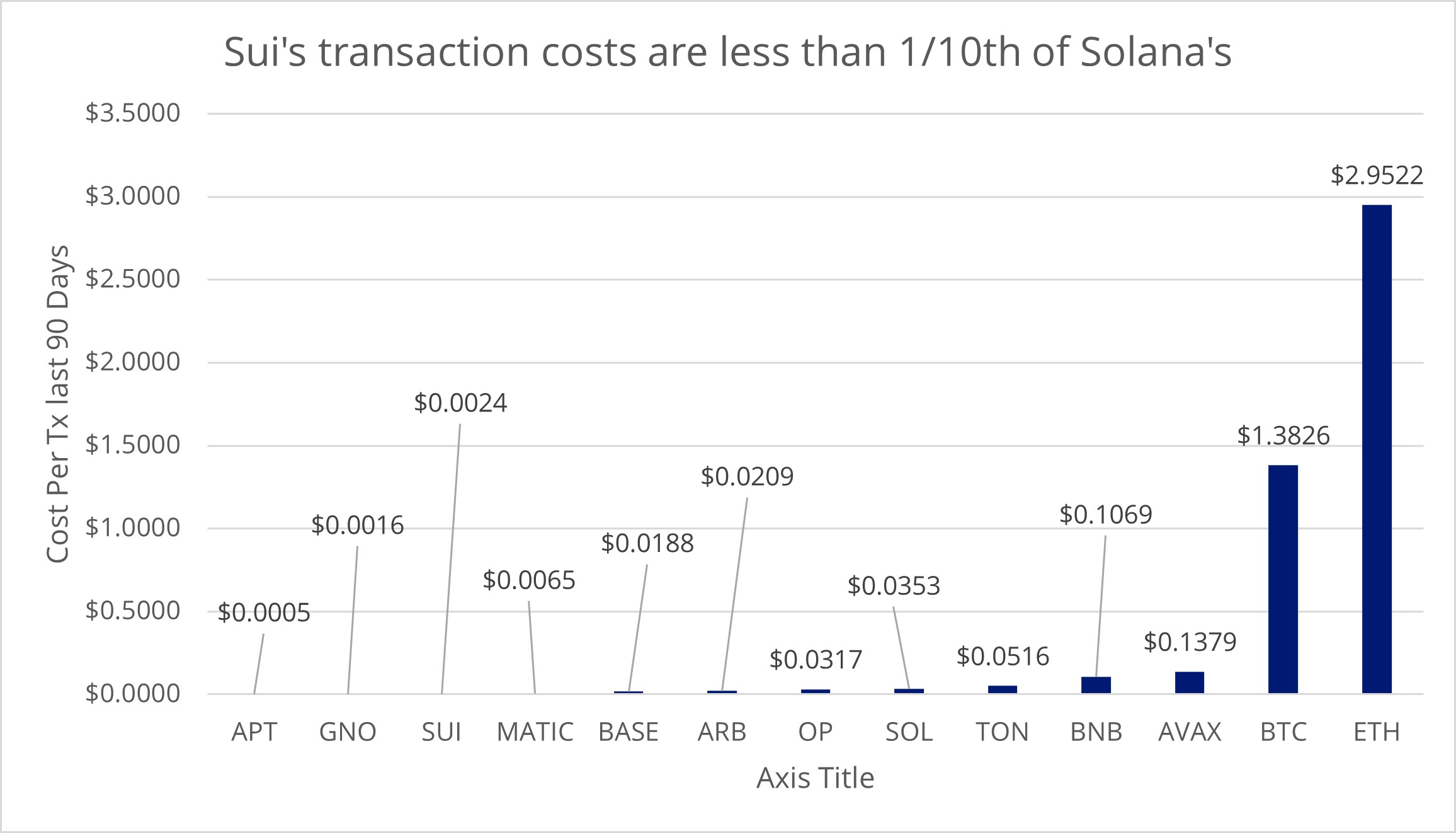
Quelle: Artemis XYZ. Stand der Daten: 28.10.2024. Die historische Wertentwicklung ist keine Garantie für zukünftige Ergebnisse. Dies sollte nicht als Finanzberatung für die in der Abbildung genannten digitalen Vermögenswerte verstanden werden.
Die Nachfrage nach einer Web2-ähnlichen Erfahrung wächst
Entwickler sind auf der Suche nach Lösungen, die eine unkomplizierte Anwendungsbereitstellung ermöglichen, mit Code, der für die Abwicklung hochwertiger Transaktionen leicht gesichert werden kann. Gleichzeitig wünschen sich die Benutzer ein Web3-Erlebnis, das sich wie eine verbesserte Version der vertrauten Web2-Umgebung anfühlt. Dazu gehören Funktionen wie nahtlose Onboarding-Prozesse, reaktionsschnelle Echtzeitanwendungen und die Möglichkeit, von Menschen lesbare Anmeldedaten oder soziale Anmeldeoptionen zu verwenden. Darüber hinaus sind Entwickler auf der Suche nach einer Sprache für Smart Contracts, die ihnen eingebaute Sicherheitsfunktionen bietet, mit denen sie ihre Nutzer vor Fehlern und ihre Anwendungen vor Ausbeutung schützen können.

Quelle: VanEck Research
Das einzigartige Blockchain-Design von SUI
Die neue Innovation von Sui besteht darin, von einem Blockchain-Design, das sich um “Konten” dreht, zu einem Design überzugehen, das sich um “Objekte” dreht. Eine Möglichkeit, über das “Konten”-Modell nachzudenken, besteht darin, jedes Asset auf Ethereum als ein Excel-Tabellenbuch zu betrachten. Bei einem Token wie USDC „senden" Sie bei einer Überweisung an jemanden nicht wirklich USDC auf dessen Konto. Das liegt daran, dass alle Guthaben von USDC in einem Smart-Contract-Ledger auf der Blockchain aufbewahrt werden, ähnlich wie in einer Excel-Tabelle. Um USDC zu transferieren, entsperrt das Konto seinen Ledger-Eintrag auf dem USDC-Kontrakt und reduziert dann sein Guthaben um den Transferbetrag, um ihn dann dem anderen Konto in diesem Smart Contract gutzuschreiben. In dieser Dynamik kontrolliert die Wallet eines Nutzers die Möglichkeit, den Ledger-Eintrag seines Guthabens auf dem USDC Smart Contract zu ändern.
Das kontobasierte Modell ist alles andere als ideal, da es weniger sicher ist und keine parallele Verarbeitung von Überweisungen zulässt. Zum ersten Punkt: Wenn der Smart Contract, der USDC antreibt, gehackt wird, können unendlich viele Münzen erzeugt und an den Hacker ausgegeben werden. Zum zweiten Punkt: Wenn mehrere Personen jeweils USDC senden möchten, muss jede von ihnen der „Excel-Tabelle” von USDC separat mitteilen, dass sie die Einheiten transferieren möchte. Das Problem dabei ist, dass der Ledger nur eine Anfrage auf einmal verarbeiten kann, da er sicherstellen muss, dass niemand mehr USDC sendet, als er auf dem Ledger hat. Um sicherzustellen, dass es keine “Doppelausgaben” gibt, müssen diese Mehrfachanträge einzeln bearbeitet werden.
Im Gegensatz dazu verwendet Sui ein „objektbasiertes” Modell, bei dem jeder Vermögenswert ein eigenes Objekt ist, das unabhängig von einem Konto existiert. Die Guthaben der Benutzer-Wallets sind keine Ledger-Einträge im Smart Contract von USDC, sondern es handelt sich um spezifische Einträge für ihre Wallets. Wenn also ein Vermögenswert zwischen Nutzern übertragen wird, verfolgt die Blockchain von Sui die Eigentumsverhältnisse in einem zentralen Ledger und nicht in einem Smart Contract. Vom Standpunkt der Blockchain aus gesehen bedeutet die Tatsache, dass jeder Vermögenswert einen unterschiedlichen Eigentümer hat, dass Sui die verschiedenen Transaktionen parallelisieren kann. Im Falle des früheren USDC-Versands kann Sui, da jeder der mehreren Benutzer seine eigenen USDC als Objekte besitzt, den Versand dieser USDC an alle diese Benutzer gleichzeitig verarbeiten. Dadurch ist Sui in der Lage, mehr Transaktionen in einer bestimmten Zeitspanne zu verarbeiten als kontobasierte Blockchains wie Ethereum.
Dieser Vorteil macht sich in Zeiten hoher Nachfrage bemerkbar, da Sui so Transaktionen, die nicht mit den stark nachgefragten Teilen der Blockchain zusammenhängen, ungehindert durchführen kann. Auch das objektbasierte Modell von Sui ermöglicht es, Transaktionen viel schneller zu bestätigen. Zum Beispiel kann Sui eine Transaktion in nur 400 Millisekunden (4/10tel einer Sekunde) abschließen, während Solana etwa 5 Sekunden, Ethereum 78 Sekunden und Bitcoin 60 Minuten benötigt.

Quelle: Sui-Daten vom 28.10.2024
Ausserdem belasten einfache Peer-to-Peer-Überweisungen (p2p) aufgrund des Eigentumsmodells von Sui die Blockchain viel weniger und können viel schneller abgeschlossen werden als bei anderen Blockchains. Da jeder Nutzer die Vermögenswerte in seinen Wallets als Objekte und nicht als Ledger-Einträge in einem Smart Contract „besitzt”, kann er einem anderen Nutzer Geld schicken, ohne den Konsens von Sui durchlaufen zu müssen. Sui nennt dies “Fast Path”. Wenn eine Peer-to-Peer-Transaktion stattfindet, muss ein Validator lediglich die Eigentumsrechte an den gesendeten Vermögenswerten prüfen und die Transaktion bestätigen, ohne dass sie einen Konsensprozess durchlaufen muss. Das spart Zeit und ermöglicht es den Validierern, ihre begrenzte Bandbreite für die Bearbeitung von mehr Transaktionen zu nutzen und gleichzeitig die Transaktionen zu beschleunigen. Genauer gesagt verkürzt der „Fast Path” von Sui eine Transaktion um bis zu 300 ms, da die Anzahl der Netzwerk-„Hops”, also der Nachrichtenübermittlung über das Netzwerk, von 4 auf 2 sinkt.
Im Gegensatz dazu müssen bei einer p2p-Überweisung auf Ethereum oder Solana die Ergebnisse mehrmals durch das gesamte Netzwerk geschickt werden, bevor die Transaktion abgeschlossen ist. Diese Dynamik macht Anwendungen der Blockchain-Technologie wie Zahlungen auf Sui so schnell, dass sie sich dem Nutzererlebnis auf Venmo oder Zelle annähern.
Schließlich verbessert das objektbasierte Modell von Sui die Erfahrung der Entwickler, indem es die Erstellung von Anwendungen erleichtert. Wenn Sie mit Sui entwickeln, müssen Sie nicht alle verschiedenen Konten angeben, die von der Anwendung berührt werden müssen, sondern nur die verallgemeinerte, viel größere Menge von Objekten. Die Entwickler müssen auch nicht alle verschiedenen Kontoabhängigkeiten angeben, was den mentalen Aufwand und den zusätzlichen Code, den sie erstellen müssen, noch erhöht. Diese Dynamik macht die Programmierung weniger fehleranfällig und ermöglicht weniger Redundanz bei der Codierung. Da das Sui-Design einen hohen Durchsatz und – übereinstimmend damit – kostengünstige Transaktionen ermöglicht, müssen Entwickler keine Workarounds entwickeln, damit ihr Code in Umgebungen mit hoher Auslastung in dem Maße funktioniert, wie sie es bei Ethereum tun müssen.
Zusammenfassend lässt sich sagen, dass Sui das Blockchain-Design weiterentwickelt hat, indem es grundlegende Änderungen vorgenommen hat, die ein besseres Produkt für Nutzer und dApp-Entwickler schaffen. Sui hat eine sicherere Blockchain geschaffen, deren Rahmenbedingungen es Sui ermöglicht, große Mengen an Informationen schnell und reaktionsschnell zu verarbeiten. In Zahlen ausgedrückt kann Sui 200 MB pro Sekunde an Informationen über seine Blockchain verarbeiten und gleichzeitig eine Transaktionsfinalität von ~400 ms ermöglichen. Im Vergleich dazu sind das etwa doppelt so viele Daten als bei Solana und eine 10-fach schnellere Finalität.
Die Attraktivität von Sui
Die Zeit, die Sui bis zur bis Finalität benötigt, übertrifft die der aktuellen Konkurrenz
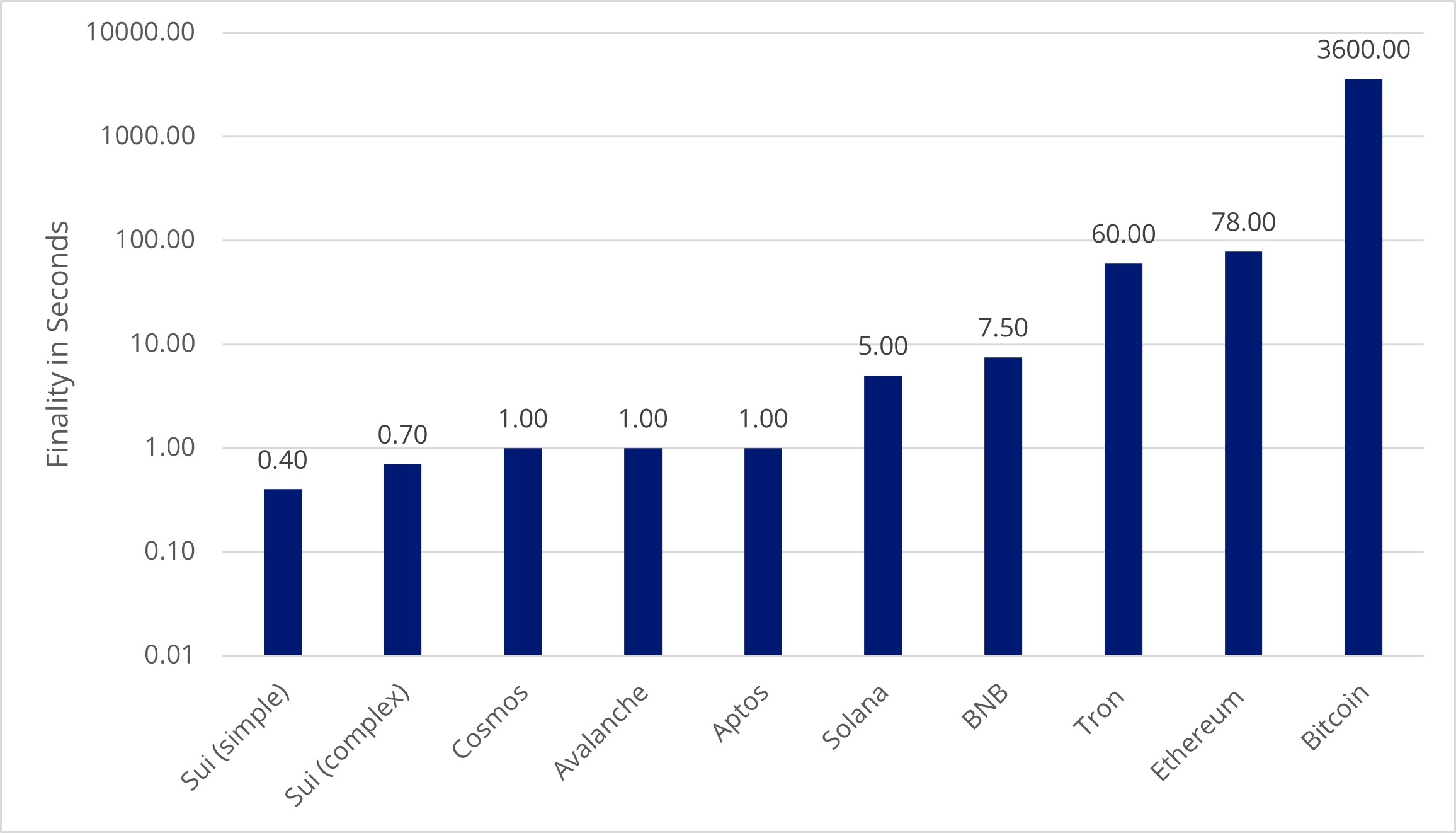
Quelle: Die Dokumentation der einzelnen Blockchains. Stand der Daten: 28.10.2024.
Was gefällt Nutzern an Sui?
Sui ermöglicht es Nutzern, Blockchain mit der Geschwindigkeit des Internets zu erleben. Benutzertransaktionen sind viel schneller, insbesondere p2p-Transaktionen, als bei vielen anderen Ketten. Da Sui in der Lage ist, Transaktionen zu parallelisieren, nimmt die Fähigkeit von Sui, neue Transaktionen zu verarbeiten, bei hoher Auslastung nicht wesentlich ab. Sui ermöglicht es Nutzern auch, ihre Wallets zu kontrollieren, indem sie sich über SSO (Secure Sign Ons) wie Facebook und Google anmelden.
Was gefällt Entwicklern an Sui?
Das Eigentumsmodell ist intuitiver als vergleichbare Blockchain-Modelle wie das EVM von Ethereum und das SVM von Solana und verhindert gleichzeitig kostspielige Fehler. Die Programmierung auf Sui erfordert bis zu 60% weniger Codezeilen im Vergleich zu Solana. Move, die in Sui verwendete Programmiersprache, verfügt über zahlreiche eingebaute Sicherheitsfunktionen. Außerdem weist die Blockchain-Software von Sui fehlerhaften Code rundheraus zurück, wenn jemand versucht, ihn auf Sui zu implementieren. Viele Angriffe, die Milliarden von Dollar gekostet haben, sind auf Sui buchstäblich unmöglich, aufgrund der Kombination Move-Sprache von Sui und seiner Software.
Was gefällt den Institutionen an Sui?
Das Datenbankmodell von Sui macht es weniger kostspielig und einfacher, die Historie von Transaktionen und Vermögenssalden auf Sui zu verstehen. Dies hilft den Institutionen zu verstehen, wer mit ihren Vermögenswerten, Anwendungen und Geldbörsen interagiert hat. Außerdem können Institutionen damit besser Informationen für Prüfungen und Steuern sammeln.
Was gefällt Anlegern an Sui?ui?
Der Staking-Mechanismus von Sui verfügt über eine sofortige Rücknahme, was den Anlegern Liquidität verschafft und gleichzeitig die Möglichkeit bietet, Staking-Belohnungen zu verdienen. Sui hat ausdrückliche Partnerschaften mit führenden Web2-Unternehmen wie ByteDance und NetMarble, um auf Sui aufzubauen. Der $SUI-Token ist sehr liquide, da er die 9.meistgehandelte Kryptowährung ist. Das Ökosystem von Sui hat auch viele potenzielle Katalysatoren, darunter das Onboarding neuer Stablecoins, Blockchain-Spiele und neuartige dePIN-Projekte.
Vergleich der wichtigsten Metriken für die Übernahme
Täglich aktive Adressen, tägliche Transaktionen und wöchentliche Commits sind wichtige Kennzahlen, um die Akzeptanz von Sui zu bewerten. Täglich aktive Adressen zeigen, wie viele einzelne Nutzer sich mit der Blockchain beschäftigen und geben einen Einblick in das Wachstum der Nutzerbasis. Die täglichen Transaktionen spiegeln den Grad der Aktivität auf der Plattform wider und zeigen an, wie häufig Benutzer mit Anwendungen interagieren. Wöchentliche Commits zeigen das Engagement der Entwickler und geben Aufschluss über das Tempo der Verbesserungen und Funktionserweiterungen. Zusammengenommen bieten diese Kennzahlen einen ausgewogenen Überblick über die Akzeptanz bei Nutzern und Entwicklern und helfen dabei, die allgemeine Zugkraft von Sui zu messen.
Täglich aktive Nutzer (% Veränderung YTD)
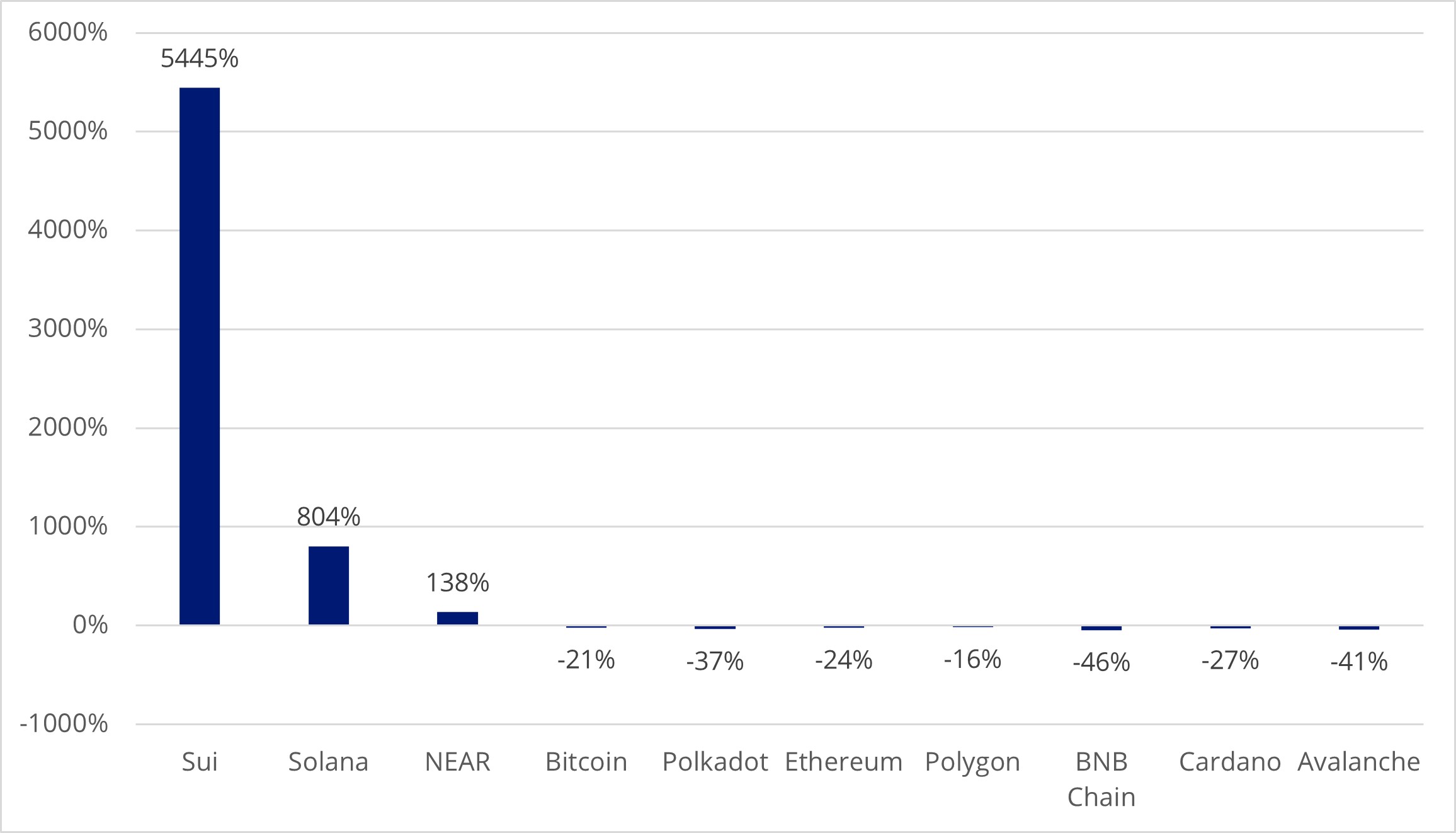
Quelle: Artemis.xyz, Daten vom 29/10/2024. Die historische Wertentwicklung ist keine Garantie für zukünftige Ergebnisse. Täglich aktive Nutzer ist definiert als die Gesamtzahl der täglich einzigartigen Blockchain-Wallets, die mit dem Protokoll interagieren (Absender). Dies sollte nicht als Anlageberatung für bestimmte digitale Vermögenswerte verstanden werden.
Tägliche Transaktionen (% Veränderung YTD)

Quelle: Artemis.xyz, Daten vom 29/10/2024. Die historische Wertentwicklung ist keine Garantie für zukünftige Ergebnisse. Tägliche Transaktionen ist definiert als die Anzahl der einzigartigen Blockchain-Interaktionen mit dem Protokoll. Dies sollte nicht als Anlageberatung für bestimmte digitale Vermögenswerte verstanden werden.
Die Entwickleraktivität auf Sui steigt seit Jahresbeginn um 53%
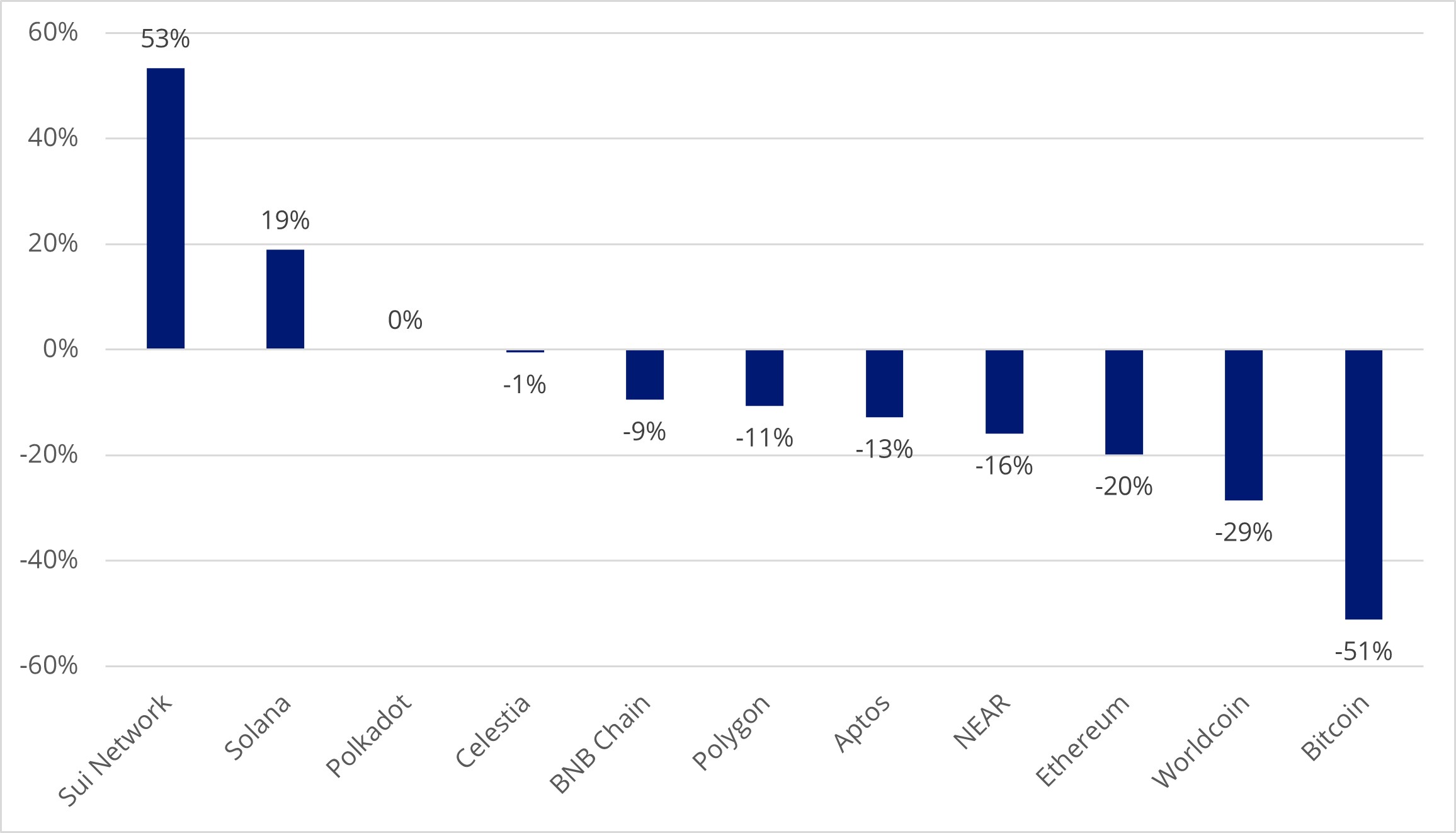
Quelle: Artemis.xyz, Daten vom 29/10/2024. Die historische Wertentwicklung ist keine Garantie für zukünftige Ergebnisse. Die Aktivität der Entwickler ist definiert als die Anzahl der wöchentlichen Commits, die in den Open-Source-Repositories des Protokolls vermerkt sind. Dies sollte nicht als Anlageberatung für bestimmte digitale Vermögenswerte verstanden werden.
Variabilität der durchschnittlichen täglichen Gasgebühr (1D % Veränderung)
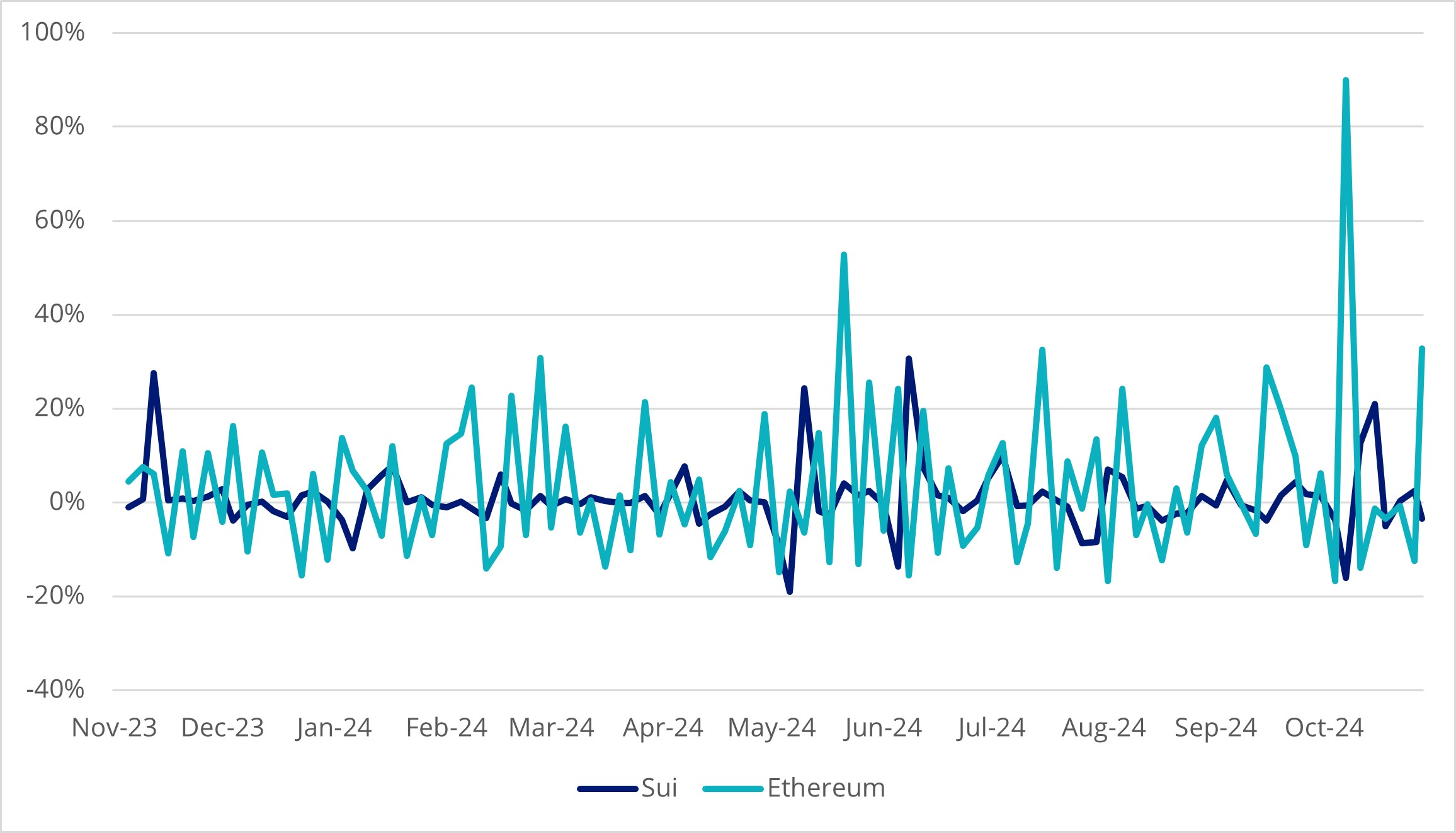
Quelle: Etherscan.io, Suivision.xyz, Daten vom 29.10.2024. Die Wertentwicklung in der Vergangenheit ist keine Garantie für künftige Ergebnisse. Dies sollte nicht als Anlageberatung für bestimmte digitale Vermögenswerte verstanden werden.
Geringere Schwankungen bei den Transaktionsgebühren verbessern die Benutzerfreundlichkeit, da die Kosten vorhersehbar und stabil sind, so dass die Benutzer ihre Transaktionen besser planen können, ohne plötzliche Gebührenspitzen befürchten zu müssen. Diese Konsistenz kann das Zögern bei der Nutzung der Plattform verringern, insbesondere bei neuen Nutzern, die mit schwankenden Gebühren nicht vertraut sind. Stabile Gebühren ermöglichen Anwendungen auch, ein reibungsloseres, zuverlässigeres Erlebnis zu bieten, da die Nutzer nicht durch unvorhersehbare Kosten abgeschreckt werden. Insgesamt machen vorhersehbare Gebühren die Plattform zugänglicher und benutzerfreundlicher, was die Akzeptanz und das Engagement fördert. Sui zeichnet sich durch eine Plattform mit konstant niedrigen Transaktionsgebühren aus.
Onboarding der nächsten Milliarde Benutzer mit zkLogin
Die Komponenten, um die nächste Milliarde Nutzer in die Blockchain von Sui einzubinden, sind Schnelligkeit, Einfachheit und niedrige Kosten. Sui fügt diesen Attributen die Einfachheit von zkLogin hinzu. zkLogin revolutioniert das Onboarding von Benutzern auf Sui, denn es ermöglicht jedem, ein Konto auf Sui mit denselben Anmeldedaten zu erstellen, die er auch für Facebook und Google verwendet. Um dieses Potenzial zu veranschaulichen, betrachten Sie, dass über 1,8 Milliarden Google-Kontoinhaber mit der zkLogin-Funktion von Sui nahtlos in den Kryptobereich wechseln könnten. Dieser innovative Ansatz ermöglicht es den Entwicklern, komplizierte und technische Schritte für die Benutzer zu eliminieren, ohne Kompromisse bei der Sicherheit einzugehen, wodurch die Einstiegshürde für Neulinge in das Web3-Ökosystem deutlich gesenkt wird.

Quelle: Sui.
Diversifizieren Sie Ihr Krypto-Engagement mit dem VanEck Sui ETN
Erleben Sie die Geschwindigkeit und Skalierbarkeit der Blockchain-Technologie der nächsten Generation. Sui bietet sofortige Finalität und parallele Transaktionsverarbeitung und ebnet damit den Weg für reaktionsschnellere und benutzerfreundlichere dezentrale Anwendungen. Die VanEck Sui ETN ist eine vollständig besicherte börsengehandelte Schuldverschreibung, die in den SUI-Token investiert.
- Vollständig besichert durch SUI im Cold Storage
- Gesamtrendite von SUI: Verfolgt den MarketVector™ Sui VWAP Close Index (MVSUIV)
Warum VanEck Crypto ETNs? Dies sind die Gründe:
- Da Kryptowährungen nur einen kleinen Teil unseres Gesamtvermögens ausmachen, können wir eine Baisse ohne drastische Maßnahmen überstehen und Ihre Investitionen schützen.
- Mit fast 70 Jahren Erfahrung in der Vermögensverwaltung und einer starken Erfolgsbilanz bei Kryptowährungen verfügen wir über fundierte Branchenkenntnisse und bewährte Zuverlässigkeit.
- Wir kombinieren traditionelle Finanzstärken mit modernster Krypto-Innovation, unterstützt von einem CEO, der wirklich an die Zukunft von Kryptowährungen glaubt.
- Wir sorgen für Klarheit in unseren Produktstrukturen und vermeiden risikoreiche oder undurchsichtige Praktiken, wobei die Vermögenswerte vollständig durch Kryptowährungen in einem sicheren Cold Storage gesichert sind.
- Unsere Produkte VBTC und VETH gehören zu den meistgehandelten auf Xetra und bieten Ihnen außergewöhnliche Liquidität und enge Spreads für einen reibungslosen Handel.
- Unsere Vermögenswerte sind durch eine lizenzierte europäische Bank in Liechtenstein abgesichert, die erstklassige Compliance und Sicherheit bietet.
- Wir verwenden die sichersten institutionellen Verwahrungssysteme, die es gibt, und stellen Ihre Sicherheit über Kosteneinsparungen.
Kryptowährungen sind eine Anlageklasse mit hohem Renditepotenzial, aber Investitionen in digitale Vermögenswerte sind mit großen Risiken verbunden. Warum also Produkte wählen, die möglicherweise noch mehr Risiken einführen? Wählen Sie VanEck für ein sicheres, transparentes und fachmännisch verwaltetes Krypto-Investment-Erlebnis.
Hauptrisikofaktoren:
- Technologierisiko: Handels- und Transaktionssysteme können gehackt werden oder fehlerhaft funktionieren, was zum Verlust digitaler Vermögenswerte führen kann.
- Regulierungsrisiko: Störungen und Eingriffe können dazu führen, dass digitale Assets illegal werden.
- Risiko des Totalverlustes: Es gibt keine Garantie für die Sicherheit der Verwahrung aufgrund von Hacking-Risiken, Kontrahentenrisiken und Marktrisiken.
- Risiko der extremen Volatilität: Die Handelspreise von digitalen Vermögenswerten können extremen Schwankungen unterliegen.
Weitere spezifische Risiken für die digitalen Vermögenswerte dieses ETNs finden Sie auch in der VanEck Crypto Academy. Zum Beispiel,
- Adoptionsrisiko: Sui ist eine alternative Layer-1 Plattform für Smart Contracts, die die Move-Sprache für Smart Contracts verwendet. Da diese Sprache zwar äquivalent, aber nicht vollständig kompatibel mit dem EVM von Ethereum ist, birgt sie ein zusätzliches Übernahmerisiko.
Wenn Sie mehr über digitale Vermögenswerte digitale Vermögenswerte erfahren möchten, abonnieren Sie unseren Newsletter.
Dies ist keine Finanzanalyse, sondern die Meinung des Autors des Artikels. Wir veröffentlichen diesen Informationen, um über aktuelle Marktentwicklungen und technologische Neuerungen zu informieren und aufzuklären. Mit diesen Informationen geben wir keine Empfehlung für bestimmte Produkte oder Projekte ab. Die Auswahl der Artikel sollte daher nicht als Finanzberatung oder Empfehlung für ein bestimmtes Produkt und/oder eine bestimmte digitale Anlage verstanden werden. Gelegentlich werden wir auch Analysen der bisherigen Marktentwicklung, Erwartungen zu Netzwerkleistungen und/oder On-Chain-Leistungen einbeziehen. Die Wertentwicklung in der Vergangenheit ist kein Hinweis auf künftige Renditen.
Wichtige Informationen
Ausschließlich zu Informations- und/oder Werbezwecken.
Diese Informationen stammen von der VanEck Switzerland AG, Genferstrasse 21, 8002 Zürich, Schweiz. Sie sind nur dazu bestimmt, Anlegern allgemeine und vorläufige Informationen zu bieten, und sollten nicht als Anlage-, Rechts- oder Steuerberatung ausgelegt werden. VanEck Switzerland AG und ihre assoziierten und verbundenen Unternehmen (gemeinsam „VanEck“) übernehmen keine Haftung in Bezug auf jegliche Investitions-, Veräußerungs- oder Retentionsentscheidung, die der Investor aufgrund dieser Angaben trifft. Die zum Ausdruck gebrachten Ansichten und Meinungen sind zum Veröffentlichungsdatum dieser Informationen aktuell und können sich mit den Marktbedingungen ändern. Bestimmte enthaltene Aussagen können Hochrechnungen, Prognosen und andere zukunftsorientierte Aussagen darstellen, die keine tatsächlichen Ergebnisse widerspiegeln. VanEck gibt weder ausdrückliche noch stillschweigende Zusicherungen oder Gewährleistungen in Bezug auf die Ratsamkeit einer Anlage in Wertpapiere oder digitale Vermögenswerte allgemein oder in das in diesen Informationen erwähnte Produkt oder die Fähigkeit des Basisindex zur Abbildung der Performance des maßgeblichen Marktes für digitale Vermögenswerte.
Der zugrunde liegende Index ist ausschliessliches Eigentum der MV Index Solutions GmbH, die mit CC Data Limited einen Vertrag zur Pflege und Berechnung des Index abgeschlossen hat. CC Data Limited bemüht sich nach besten Kräften, eine korrekte Berechnung des Index zu gewährleisten. Ungeachtet ihrer Verpflichtungen gegenüber der MV Index Solutions GmbH ist die CC Data Limited nicht verpflichtet, Dritte auf Fehler im Index hinzuweisen.
Eine Anlage ist mit Risiken verbunden, einschließlich des möglichen Verlusts des Kapitals bis zum gesamten Anlagebetrag. Außerdem können ETNs extremer Volatilität unterliegen. Sie müssen den Prospekt und das Basisinformationsblatt vor einer Anlagetätigkeit lesen, um die potenziellen Risiken und Chancen, die mit der Entscheidung für eine Anlage in das Produkt verbunden sind, vollständig zu verstehen. Den genehmigten Prospekt finden Sie unter www.vaneck.com. Bitte beachten Sie, dass die Genehmigung des Prospekts nicht als Befürwortung der an einem geregelten Markt angebotenen oder zum Handel zugelassenen Produkte zu verstehen ist.
Angaben zur Wertentwicklung beziehen sich auf die Vergangenheit und stellen keine Garantie für die künftige Wertentwicklung dar. Die zukünftige Wertentwicklung kann niedriger oder höher sein als die aktuelle.
Die aktuelle Wertentwicklung kann im Vergleich zu den aufgeführten durchschnittlichen jährlichen Renditen höher oder niedriger ausfallen. Die jährlichen Performancedaten zeigen die Wertentwicklung in den zwölf Monaten bis zum letzten Quartalsende und gegebenenfalls für die fünf vorausgegangenen Jahre. Beispielsweise entspricht das „1. Jahr” der letzten dieser zwölfmonatigen Perioden, das „2. Jahr” den vorigen 12 Monaten und so weiter. Performancedaten werden in Basiswährung, mit wiederangelegten Nettoerträgen und nach Abzug der Gebühren angezeigt. Makler- oder Transaktionsgebühren kommen zur Anwendung. Anlageerträge und der Kapitalwert einer Anlage unterliegen Schwankungen. Die Schuldverschreibungen können bei Rücknahme einen höheren oder geringeren Wert haben als der ursprünglich gezahlte Betrag.
Indexrenditen entsprechen nicht den ETN-Renditen und berücksichtigen keine Management- oder Maklergebühren. Die Wertentwicklung des Index ist nicht repräsentativ für die Wertentwicklung des ETN. Anleger können nicht direkt in den Index investieren. Indizes sind keine Wertpapiere, in die investiert werden kann.
Ohne ausdrückliche schriftliche Genehmigung von VanEck ist es nicht gestattet, Inhalte dieser Publikation zu vervielfältigen oder in einer anderen Publikation auf sie zu verweisen.
© VanEck Switzerland AG
Wichtige Hinweise
Ausschließlich zu Informations- und/oder Werbezwecken.
Diese Informationen stammen von VanEck (Europe) GmbH, die von der nach niederländischem Recht gegründeten und bei der niederländischen Finanzmarktaufsicht (AFM) registrierten Verwaltungsgesellschaft VanEck Asset Management B.V. zum Vertrieb der VanEck-Produkte in Europa bestellt wurde. Die VanEck (Europe) GmbH mit eingetragenem Sitz unter der Anschrift Kreuznacher Str. 30, 60486 Frankfurt, Deutschland, ist ein von der Bundesanstalt für Finanzdienstleistungsaufsicht (BaFin) beaufsichtigter Finanzdienstleister. Die Angaben sind nur dazu bestimmt, Anlegern allgemeine und vorläufige Informationen zu bieten, und sollten nicht als Anlage-, Rechts- oder Steuerberatung ausgelegt werden. Die VanEck (Europe) GmbH und ihre verbundenen und Tochterunternehmen (gemeinsam „VanEck“) übernehmen keine Haftung in Bezug auf Investitions-, Veräußerungs- oder Retentionsentscheidungen, die der Investor aufgrund dieser Informationen trifft. Die zum Ausdruck gebrachten Ansichten und Meinungen sind die des Autors bzw. der Autoren, aber nicht notwendigerweise die von VanEck. Die Meinungen sind zum Zeitpunkt der Veröffentlichung aktuell und können sich mit den Marktbedingungen ändern. Bestimmte enthaltene Aussagen können Hochrechnungen, Prognosen und andere zukunftsorientierte Aussagen darstellen, die keine tatsächlichen Ergebnisse widerspiegeln. Es wird angenommen, dass die von Dritten bereitgestellten Informationen zuverlässig sind. Diese Informationen wurden weder von unabhängigen Stellen auf ihre Korrektheit oder Vollständigkeit hin geprüft noch können sie garantiert werden. Alle genannten Indizes sind Kennzahlen für übliche Marktsektoren und Wertentwicklungen. Es ist nicht möglich, direkt in einen Index zu investieren.
Alle Angaben zur Wertentwicklung beziehen sich auf die Vergangenheit und sind keine Garantie für zukünftige Ergebnisse. Anlagen sind mit Risiken verbunden, die auch einen möglichen Verlust des eingesetzten Kapitals einschließen können. Sie müssen den Verkaufsprospekt und die KID lesen, bevor Sie eine Anlage tätigen.
Ohne ausdrückliche schriftliche Genehmigung von VanEck ist es nicht gestattet, Inhalte dieser Publikation in jedweder Form zu vervielfältigen oder in einer anderen Publikation auf sie zu verweisen.
© VanEck (Europe) GmbH
Jetzt zum Newsletter anmelden
Verwandte Einblicke
Related Insights
10 Oktober 2024
14 März 2025
16 Januar 2025
05 November 2024
10 Oktober 2024




